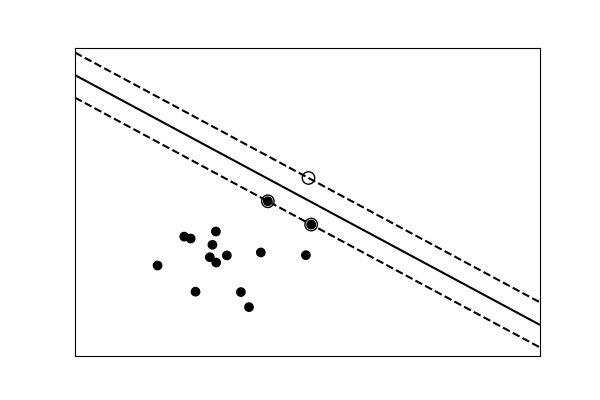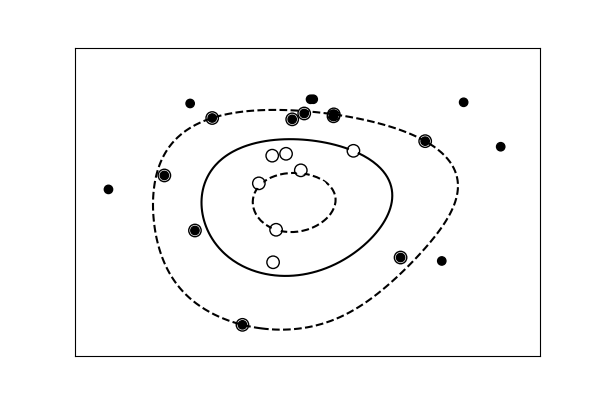Note
Click here to download the full example code
3.6.10.15. Example of linear and non-linear models¶
This is an example plot from the tutorial which accompanies an explanation of the support vector machine GUI.
import numpy as np
from matplotlib import pyplot as plt
from sklearn import svm
data that is linearly separable
def linear_model(rseed=42, n_samples=30):
" Generate data according to a linear model"
np.random.seed(rseed)
data = np.random.normal(0, 10, (n_samples, 2))
data[:n_samples // 2] -= 15
data[n_samples // 2:] += 15
labels = np.ones(n_samples)
labels[:n_samples // 2] = -1
return data, labels
X, y = linear_model()
clf = svm.SVC(kernel='linear')
clf.fit(X, y)
plt.figure(figsize=(6, 4))
ax = plt.subplot(111, xticks=[], yticks=[])
ax.scatter(X[:, 0], X[:, 1], c=y, cmap=plt.cm.bone)
ax.scatter(clf.support_vectors_[:, 0],
clf.support_vectors_[:, 1],
s=80, edgecolors="k", facecolors="none")
delta = 1
y_min, y_max = -50, 50
x_min, x_max = -50, 50
x = np.arange(x_min, x_max + delta, delta)
y = np.arange(y_min, y_max + delta, delta)
X1, X2 = np.meshgrid(x, y)
Z = clf.decision_function(np.c_[X1.ravel(), X2.ravel()])
Z = Z.reshape(X1.shape)
ax.contour(X1, X2, Z, [-1.0, 0.0, 1.0], colors='k',
linestyles=['dashed', 'solid', 'dashed'])

data with a non-linear separation
def nonlinear_model(rseed=42, n_samples=30):
radius = 40 * np.random.random(n_samples)
far_pts = radius > 20
radius[far_pts] *= 1.2
radius[~far_pts] *= 1.1
theta = np.random.random(n_samples) * np.pi * 2
data = np.empty((n_samples, 2))
data[:, 0] = radius * np.cos(theta)
data[:, 1] = radius * np.sin(theta)
labels = np.ones(n_samples)
labels[far_pts] = -1
return data, labels
X, y = nonlinear_model()
clf = svm.SVC(kernel='rbf', gamma=0.001, coef0=0, degree=3)
clf.fit(X, y)
plt.figure(figsize=(6, 4))
ax = plt.subplot(1, 1, 1, xticks=[], yticks=[])
ax.scatter(X[:, 0], X[:, 1], c=y, cmap=plt.cm.bone, zorder=2)
ax.scatter(clf.support_vectors_[:, 0], clf.support_vectors_[:, 1],
s=80, edgecolors="k", facecolors="none")
delta = 1
y_min, y_max = -50, 50
x_min, x_max = -50, 50
x = np.arange(x_min, x_max + delta, delta)
y = np.arange(y_min, y_max + delta, delta)
X1, X2 = np.meshgrid(x, y)
Z = clf.decision_function(np.c_[X1.ravel(), X2.ravel()])
Z = Z.reshape(X1.shape)
ax.contour(X1, X2, Z, [-1.0, 0.0, 1.0], colors='k',
linestyles=['dashed', 'solid', 'dashed'], zorder=1)
plt.show()

Total running time of the script: ( 0 minutes 0.047 seconds)
